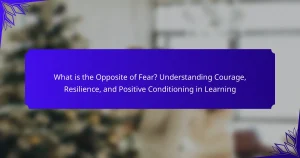Organized chaos fosters an environment where learners can thrive amidst unpredictability. This article explores adaptive learning, emotional resilience, and effective conditioning techniques. It addresses the universal, unique, and rare attributes of organized chaos. Additionally, it discusses the challenges of implementation and strategies for fostering a successful learning atmosphere.
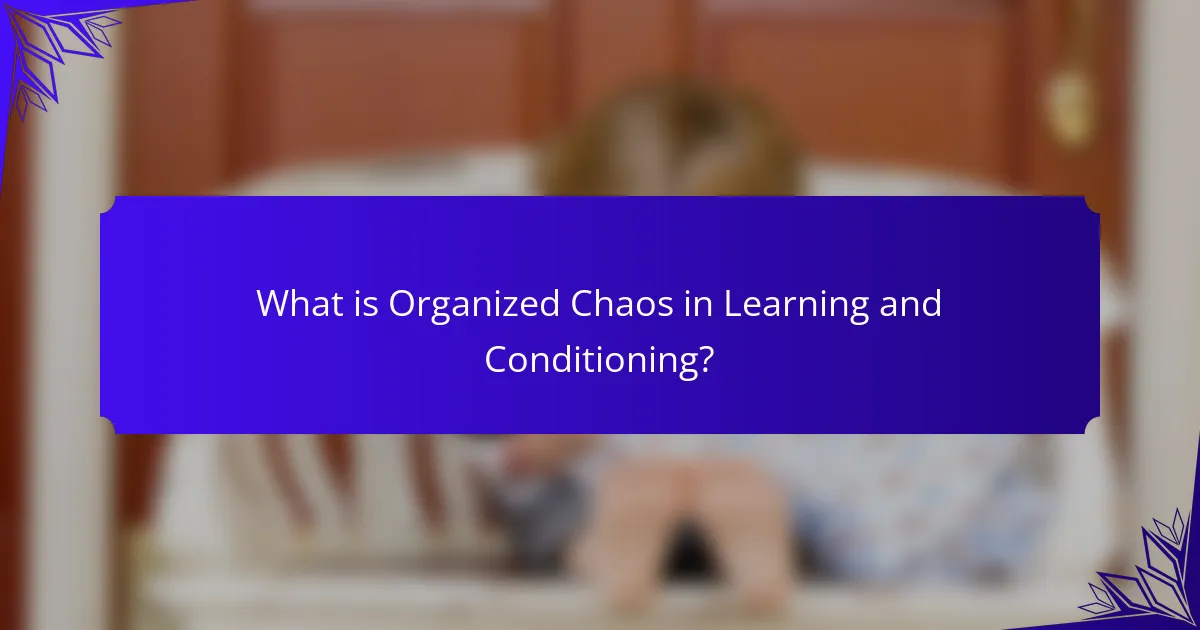
What is Organized Chaos in Learning and Conditioning?
Organized chaos in learning and conditioning refers to a structured yet flexible approach that fosters adaptive learning and emotional resilience. This methodology allows learners to thrive in unpredictable environments, enhancing their ability to adapt and respond to challenges. Effective conditioning techniques within this framework encourage exploration and creativity, promoting deeper understanding and retention of knowledge. By embracing organized chaos, educators can cultivate an environment that balances structure with the freedom to innovate, ultimately leading to more effective learning outcomes.
How does Adaptive Learning contribute to Organized Chaos?
Adaptive Learning enhances Organized Chaos by personalizing educational experiences, fostering emotional resilience, and implementing effective conditioning techniques. This approach allows learners to navigate complexity through tailored feedback and adaptive pathways, promoting engagement and mastery. By cultivating adaptability, learners develop skills to thrive in unpredictable environments, ultimately leading to improved outcomes.
What are the key principles of Adaptive Learning?
Adaptive learning is centered around personalization, allowing education to adjust to individual needs. Key principles include continuous assessment, where feedback informs learning paths, and flexibility, enabling learners to progress at their own pace. Emotional resilience is vital, as it helps learners navigate challenges, fostering persistence. Effective conditioning techniques, such as spaced repetition, enhance retention and mastery. Together, these principles create a dynamic learning environment that promotes engagement and success.
What technologies support Adaptive Learning?
Adaptive learning is supported by various technologies, including learning management systems, artificial intelligence, data analytics, and cloud computing. These tools personalize educational experiences, allowing for real-time adjustments based on learner performance and preferences. For instance, AI algorithms analyze user interactions to tailor content, enhancing engagement and retention. Additionally, data analytics track progress, identifying areas for improvement, while cloud computing facilitates access to resources anytime, anywhere.
In what ways does Emotional Resilience play a role?
Emotional resilience enhances adaptability during challenges, fostering recovery and growth. It promotes mental well-being by enabling individuals to manage stress effectively. This attribute supports sustained motivation, allowing for continuous learning and improvement. Emotional resilience ultimately contributes to long-term success in adaptive learning environments.
What are the components of Emotional Resilience?
Emotional resilience consists of components such as self-awareness, emotional regulation, optimism, and social support. These elements enable individuals to adapt to stress and recover from challenges effectively. Self-awareness helps in recognizing emotions, while emotional regulation involves managing responses. Optimism fosters a positive outlook, and social support provides necessary connections for coping.
How can Emotional Resilience be developed?
Emotional resilience can be developed through intentional practices and techniques. Key strategies include fostering a growth mindset, practicing mindfulness, and building strong social connections. Engaging in adaptive learning helps individuals respond effectively to challenges, enhancing their ability to cope with stress. Regularly reflecting on experiences and seeking feedback can also strengthen resilience.
What Effective Conditioning Techniques are essential?
Effective conditioning techniques include progressive overload, varied training stimuli, and consistent feedback. These methods enhance adaptability, promote emotional resilience, and ensure optimal learning. Progressive overload gradually increases demands to improve performance. Varied training stimuli prevent monotony and encourage engagement. Consistent feedback reinforces positive behaviors and fosters growth.
What are the core features of Effective Conditioning Techniques?
Effective conditioning techniques enhance learning by fostering adaptability, emotional resilience, and structured practice. Key features include personalized feedback, gradual progression, varied stimuli, and the integration of emotional support. These elements create an environment conducive to sustained engagement and skill development.
How do these techniques differ from traditional methods?
Adaptive learning, emotional resilience, and effective conditioning techniques differ from traditional methods by emphasizing flexibility, emotional intelligence, and personalized approaches. Traditional methods often rely on rigid structures and standardized assessments. In contrast, adaptive learning tailors educational experiences to individual needs, enhancing engagement and retention. Emotional resilience techniques focus on managing stress and fostering a growth mindset, while effective conditioning incorporates real-time feedback to optimize learning outcomes. This shift towards a more holistic and responsive framework marks a significant evolution in educational practices.
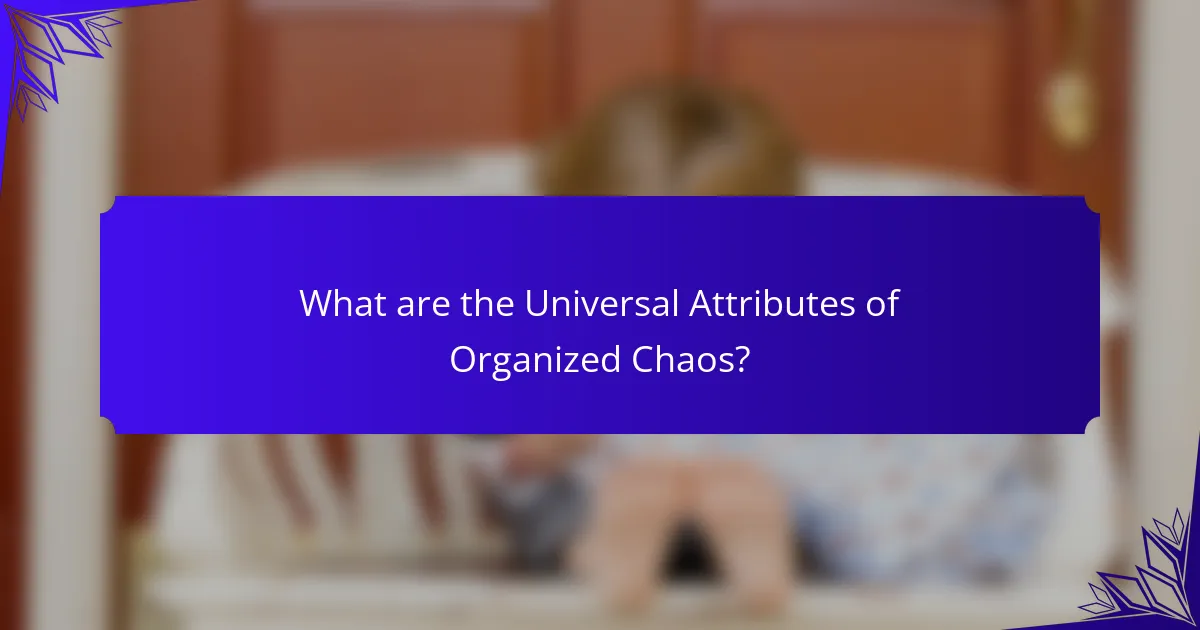
What are the Universal Attributes of Organized Chaos?
The universal attributes of organized chaos include adaptability, emotional resilience, and effective conditioning techniques. Adaptability allows individuals to navigate unpredictability, while emotional resilience helps them cope with stress. Effective conditioning techniques foster learning in dynamic environments. Together, these attributes create a framework for thriving amidst uncertainty.
How does flexibility enhance learning outcomes?
Flexibility enhances learning outcomes by promoting adaptive learning, emotional resilience, and effective conditioning techniques. These elements allow learners to adjust their strategies, cope with challenges, and reinforce positive behaviors. Adaptive learning fosters personalized educational experiences, improving engagement and retention. Emotional resilience equips learners to navigate setbacks, enhancing persistence. Effective conditioning techniques reinforce desired behaviors, leading to better performance and knowledge retention. Together, these aspects create a dynamic learning environment conducive to success.
What role does feedback play in Adaptive Learning?
Feedback is crucial in adaptive learning as it provides personalized insights that guide learners’ progress. It enhances emotional resilience by fostering a growth mindset and motivating continuous improvement. Effective conditioning techniques, tailored through feedback, allow learners to adapt their strategies for better outcomes. This iterative process ensures that learning experiences are optimized for individual needs, ultimately leading to more effective educational results.

What Unique Attributes distinguish Organized Chaos?
Organized Chaos is distinguished by its unique attributes of adaptive learning, emotional resilience, and effective conditioning techniques. These attributes enable individuals to thrive in unpredictable environments. Adaptive learning allows for flexibility in problem-solving. Emotional resilience fosters the ability to cope with stress and setbacks. Effective conditioning techniques enhance skill acquisition and behavioral adaptation.
How does personalization affect learner engagement?
Personalization significantly enhances learner engagement by tailoring educational experiences to individual needs. Adaptive learning platforms analyze learner behavior and preferences, allowing for customized content delivery. This approach fosters emotional resilience as learners feel more connected to their education. Effective conditioning techniques, such as positive reinforcement, further boost motivation and retention. Personalization ultimately leads to improved learning outcomes and satisfaction.
What innovative practices enhance Emotional Resilience?
Innovative practices that enhance emotional resilience include mindfulness training, cognitive restructuring, and adaptive coping strategies. Mindfulness training promotes present-moment awareness, reducing stress and improving emotional regulation. Cognitive restructuring helps individuals reframe negative thoughts, fostering a more positive outlook. Adaptive coping strategies, such as problem-solving and seeking social support, empower individuals to navigate challenges effectively. These practices collectively build a robust framework for emotional resilience, enabling better responses to adversity.

What Rare Attributes can be found in Organized Chaos?
Organized chaos exhibits rare attributes such as dynamic adaptability, spontaneous creativity, and unconventional problem-solving. These characteristics enable individuals to thrive in unpredictable environments while fostering emotional resilience and effective conditioning techniques.
What unexpected benefits arise from Organized Chaos?
Organized Chaos fosters creativity, adaptability, and innovative problem-solving. It encourages emotional resilience by allowing individuals to embrace uncertainty and learn from failures. This approach enhances effective conditioning techniques, leading to improved performance under pressure. Additionally, it promotes collaboration, as diverse perspectives flourish in dynamic environments.
How can Organized Chaos be applied in unconventional settings?
Organized Chaos can be effectively applied in unconventional settings by promoting adaptability and fostering innovation. This approach encourages individuals to embrace uncertainty, enhancing emotional resilience in unpredictable environments. Techniques such as collaborative brainstorming and flexible project management empower teams to navigate challenges creatively. As a result, organizations can leverage diverse perspectives, leading to unique solutions and improved outcomes.
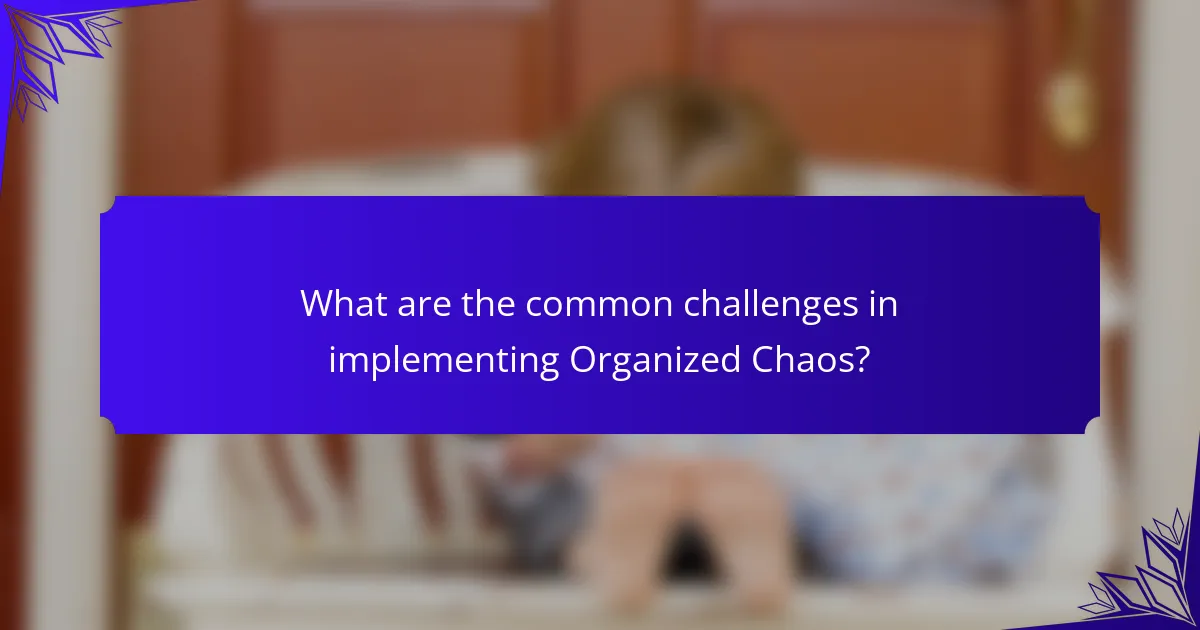
What are the common challenges in implementing Organized Chaos?
Implementing Organized Chaos faces several challenges, including resistance to change, lack of clarity in objectives, and insufficient training. Resistance to change arises when individuals are accustomed to traditional methods and hesitant to adopt adaptive learning strategies. Lack of clarity in objectives can lead to confusion about the goals of the Organized Chaos approach, hindering effective implementation. Insufficient training in emotional resilience and conditioning techniques may result in inadequate adaptation, limiting the potential benefits of this methodology. Addressing these challenges is crucial for successful implementation.
What strategies can overcome resistance to change?
To overcome resistance to change, implement strategies that foster adaptive learning, emotional resilience, and effective conditioning techniques. Engaging employees in the change process enhances their understanding and acceptance. Providing training programs builds adaptive learning capabilities, enabling individuals to navigate new environments confidently. Encouraging open communication fosters emotional resilience, allowing team members to express concerns and contribute solutions. Utilizing positive reinforcement techniques conditions individuals to embrace change, making transitions smoother and more effective.
How can organizations measure success in Adaptive Learning?
Organizations can measure success in Adaptive Learning by tracking learner engagement, performance improvements, and retention rates. Key metrics include completion rates of personalized learning paths, assessments scores over time, and feedback from learners on their experiences. Additionally, analyzing data trends can reveal the effectiveness of specific conditioning techniques and emotional resilience strategies, allowing for continuous improvement in adaptive learning frameworks. Regular evaluations help align learning outcomes with organizational goals, ensuring that adaptive learning initiatives yield meaningful results.
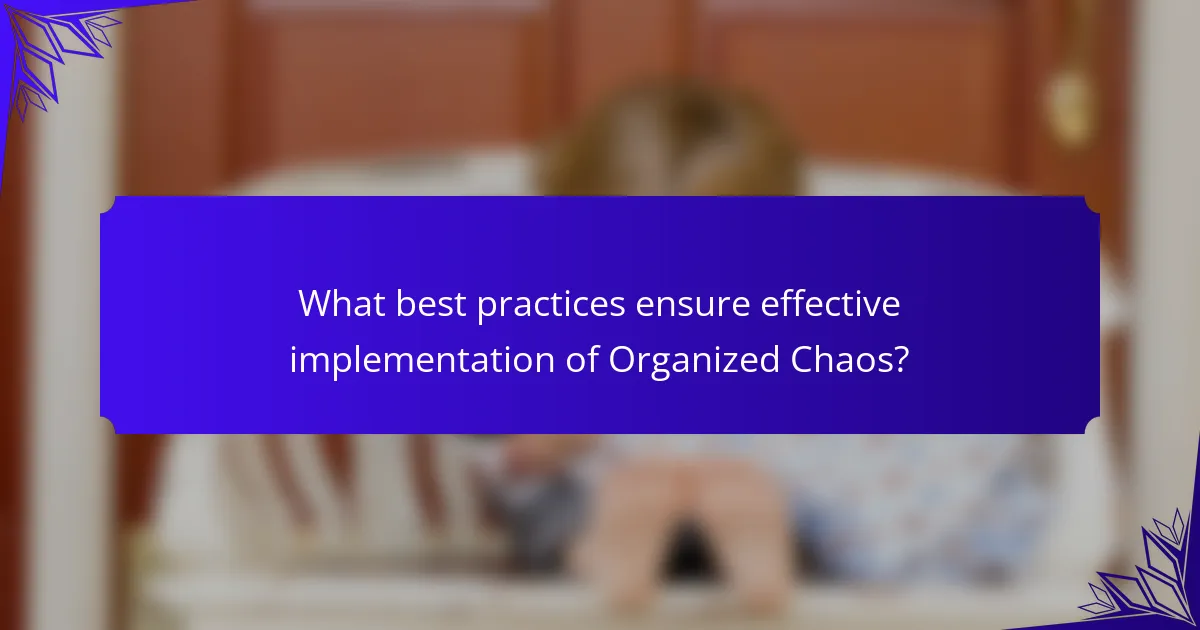
What best practices ensure effective implementation of Organized Chaos?
Effective implementation of Organized Chaos requires fostering adaptive learning, building emotional resilience, and applying effective conditioning techniques. Prioritize creating an environment that encourages experimentation and flexibility. Establish clear objectives while allowing for spontaneous adaptations. Promote collaboration and open communication among team members to enhance collective problem-solving. Regularly assess and adjust strategies based on feedback and outcomes to ensure continuous improvement.
What are the key optimization tips for Adaptive Learning environments?
To optimize adaptive learning environments, focus on personalized content delivery, real-time feedback, and fostering emotional resilience. Incorporate data analytics to tailor learning experiences and ensure effective conditioning techniques are applied. Regularly assess learner progress to adapt strategies accordingly.
What common mistakes should be avoided in Emotional Resilience training?
To enhance Emotional Resilience training, avoid common mistakes such as neglecting individual differences, underestimating the importance of practice, and failing to provide adequate feedback. Recognizing that each person has unique emotional responses is crucial. Consistent practice reinforces adaptive learning, while constructive feedback guides improvement. Additionally, overlooking the role of self-reflection can hinder personal growth in emotional resilience.
How can one maintain a balance between structure and chaos in learning?
To maintain a balance between structure and chaos in learning, one should embrace organized chaos through adaptive learning techniques. This approach allows for flexibility while fostering emotional resilience. Effective conditioning techniques can help learners thrive in dynamic environments, enhancing their ability to adapt and grow.


